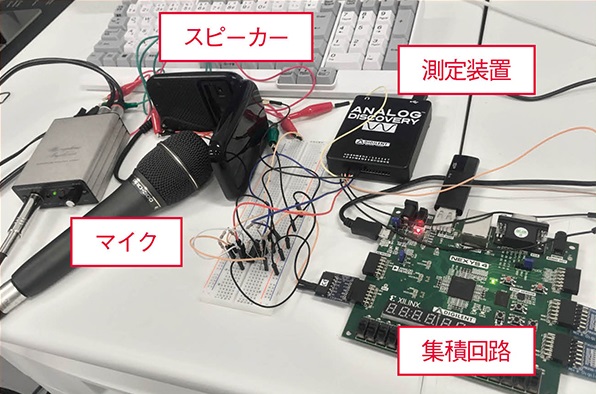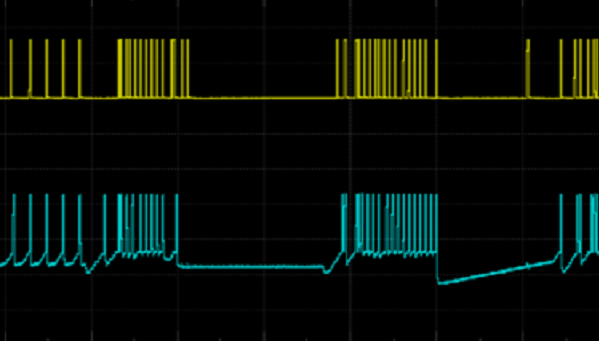reseach
Social Contributions through Innovative Electrical and Electronic Circuits for Biomimetic Application to the Field of Medical Engineering
Hiroyuki Torikai, Professor
Department of Electrical and Electronic Engineering, Faculty of Science and Engineering
Posted Oct.16,2020
Faculty Profile
Professor Hiroyuki Torikai is pursuing electrical and electronic circuit designs that enable the imitation of natural properties of living organisms.
He is working to create artificial functions of the human inner ear and brain to reduce limitations associated with physical disabilities.
Designing circuits that enable artificial imitation of cochlear and brain functions
I specialize in research related to electrical and electronic circuits (hereinafter, “circuits”). My recent studies center around Very Large-Scale Integration (VLSI)* designs for biomimetic engineering, with a focus on cochlear and brain functions.
My interest in circuit designs started when I was a teenager, and I became a researcher in the field to pursue basic theory studies. My career came to a significant turning point in 2005, when I participated in an international conference, where I first encountered research endeavors aimed at developing integrated circuits that can substitute for part of the brain’s functions. I thought I could apply my achievements from years of research activities to medical engineering. I was intrigued by this possibility.
In the medical engineering field, circuit designers have made major contributions to the cochlear implant process. The cochlea is the innermost part of the ear that involves hearing. The organ converts sound information coming from the outer ear to electrical signals to be transmitted to the brain. The cochlear implant process has been developed to produce equivalent functionality by leveraging VLSI technology, with the aim of fixing hearing impairments due to cochlear damage.
Cochlear implant technology is already in practical use, and has advanced to levels that enable normal conversation. The major challenge at present, however, is inadequate sound quality. Therefore, I am working on improving accuracy to provide clearer sound recognition, aiming to achieve the equivalent of the natural hearing function of the inner ear (see Figure 1).
Engineering for the brain poses a more formidable challenge. As the brain is a complex central system, it is difficult to create a single mechanism that can operate as a substitute for the whole system. Thus, current circuit design efforts focus on creating versatile master platforms that allow flexible circuit arrangements to be able to substitute for part of the brain functions. Many such efforts are focusing on the hippocampus, part of the limbic system that plays important roles in the consolidation of new memories and spatial orientation (see Figure 2).
Biomimetic projects targeting hippocampal functions are being promoted worldwide, mainly in the United States. There has been remarkable progress in this research field since 2005, when I was intrigued by presentations on experiments with rats at the international conference. In 2018, notable reports were published on the results of basic experiments aimed at clinical application to repairing damages of the human brain, which showed minimal but significant improvements in the human brain function.
Related research activities will be spurred toward practical application in the coming years. Given the potential of circuit designs to improve performance, I am pursuing advanced research in anticipation of future demand.
-

Figure 1 Experimental arrangement for circuit designs of a cochlear implant. The equipment assesses the accuracy of the conversion of sounds collected through a microphone into electric signals.
-

Figure 2 Electrogram of artificial hippocampal circuits. Using equipment that presents brain waves associated with hippocampal activity, researchers handle two sets of comparative data from animal experiments and artificial circuits in order to match wave patterns.
Promoting ingenuity to create wisdom utilizing intellectual resources from predecessors
I started to build my career as a researcher at Hosei University. I worked at other universities in the Kansai region for years before returning to my alma mater in 2018. My laboratory is located on the Koganei Campus, where I studied as a student. The appearance of the campus has changed due to the redevelopment project, including refurbished school buildings. However, I feel that the present students look generally unchanged from those I knew in the past.
The Koganei Campus attracts many inspiring researchers who pursue innovations, exercising their own ingenuity and wisdom. This is possible thanks to Hosei University providing an environment that encourages such academic professionalism.
Knowledge of electrical and electronic engineering will help develop the biomimetic engineering technology, but it also requires knowledge from other fields. The most essential is anatomical knowledge about the structure of the target organs and their functional mechanisms in relation to nerves and other organ cells. For this purpose, it is vitally important to ensure accessibility to achievements and measurement data from preceding research efforts in the fields of biology and medical science.
I will bring together knowledge and insights accumulated by many preceding researchers in respective fields of specialization to apply to my studies, aiming to contribute to society.
Encouraging students to engage in robust basic research to become leading engineers
Successful biomimetic engineering projects can artificially reproduce biological functions. This achievement can be applied not only to medical engineering but also to other fields of science.
In my laboratory, a number of students are working on applied research.
One such project was to develop an electronic brain for robotic insects. The project designed circuits that can effectively imitate the insect’s brain mechanism to provide six-legged robots with insectile locomotion patterns.
Other student engaged in a project involved the design and development of gene simulators, intended for gene therapy in the fields of genomic medicine and drug discovery.
The gene simulator reproduces actions of intercellular genes and proteins for the purpose of simulating how medicines will act on specific genes.
In order to produce effective application results that can serve society as practical wisdom, you should engage in robust basic research to build a solid research foundation. Solid basic knowledge is the key to versatile application development.
In recent years, research activities have been expanding in many countries, especially China and India, a phenomenon that is seemingly overshadowing Japan’s research activities. Going forward, the research sector will become more diversified and internationalized. Given this context, I feel Japan is facing an urgent need to develop competent engineers and researchers to duly demonstrate its potential research capabilities. I hope to play a role in addressing this task.
Very Large Scale Integration (VLSI) is the process of creating an integrated circuit by combining numerous transistors onto a single chip using semiconductor device fabrication processes. The resultant products are called very large scale integrated circuits.

Every summer, the laboratory organizes a joint study camp inviting graduate and undergraduate students together. Third-year students receive intensive training in basic circuit design, while senior students present a report on individual research projects
Hiroyuki Torikai, Professor
Department of Electrical and Electronic Engineering, Faculty of Science and Engineering
Born in Hyogo in 1973.
Graduated from the Department of Electrical Engineering, Faculty of Engineering (present Faculty of Science and Engineering), Hosei University, and completed the Master’s and Doctoral programs of the Graduate School of Engineering with a Major in Electrical Engineering at the same institution. Doctor of Engineering Served as Assistant at the Department of Information, Electrical and Electronic Engineering, Faculty of Engineering, Hosei University; Associate Professor at the Graduate School of Engineering Science, Osaka University; and Professor at the Faculty of Computer Science and Engineering, Kyoto Sangyo University; before assuming the current position of Professor at the Faculty of Science and Engineering, Hosei University in April 2018.

